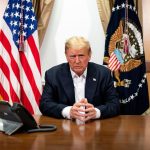President Trump has wasted no time in asserting a bold new economic strategy that includes hefty tariffs on imports from Canada, Mexico, and China. On a recent weekend, the President made it clear that while these tariffs may cause some temporary discomfort for American consumers, the long-term benefits will be well worth it. In a world where globalist interests often overshadow American prosperity, Trump remains steadfast in his commitment to putting America first.
The reasoning behind these tariffs isn’t just bravado; it’s rooted in sound economic principles. A 2024 analysis by McKinsey & Company suggests that imposing tariffs on imported goods actually reduces the competition faced by American producers, thereby increasing demand for domestically manufactured goods. This shift not only creates jobs but also rejuvenates the manufacturing sector, an area that has suffered in recent decades. Historical data reveals that Trump’s tariffs have already led to significant reshoring of jobs back to the United States, particularly in manufacturing and steel industries, dispelling the unfounded fears that such measures would harm the economy.
Acknowledging the potential short-term pain at the checkout line, Trump emphasized a larger vision—a golden age for America where products are made in the USA and the economy thrives. His confident assertion that “it will all be worth it” aligns with a broader narrative that Americans should expect some challenges during the transition to a more self-reliant economy. While critics may crow about increased prices, Trump argues that the long-term gains in job creation and wage increases far outweigh any initial inconveniences.
Trump: Tariffs May Hurt, but ‘Will All Be Worth It’ in the Long Run https://t.co/WAx7q9CFUN
— Lora Connor (@LoraConnor7) February 3, 2025
Adding an interesting twist to his economic rhetoric, the President has floated the idea of annexing Canada, proposing that it should become the Cherished 51st State. While Canada’s leadership has brushed off such proposals, it highlights Trump’s signature willingness to shake up the status quo. If anything, this cheeky suggestion underscores his commitment to creating a stronger economic partnership that benefits Americans directly—or perhaps serves as a clever negotiation tactic to pressure Canadian leaders into more favorable trade terms.
The primary driving force behind these tariffs is not only economic revitalization but also a concerted effort to tackle illegal immigration and drug trafficking along U.S. borders. The administration’s focus on both growing American manufacturing and ensuring national security illustrates a coherent strategy to create a safer, more prosperous nation. As the tariffs take effect, it remains to be seen how Canada and Mexico will respond to Trump’s call for increased accountability on these critical issues. This approach breaks from the previous administration’s more lenient stance and reinforces the notion that America will no longer be taken advantage of on the global stage.




